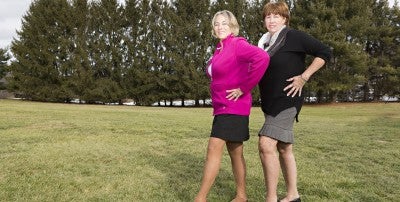
Judy Barwis’ mom wasn’t going to let her off the hook. “For some time, she was telling me to get my swollen leg checked out at Lehigh Valley Health Network (LVHN),” says Barwis, a 67-year-old retired secretary from Churchville, Bucks County. Barwis, who experienced swelling below her surgically replaced left knee in 2007, wanted to listen but kept deferring. “I had it checked out by seven different doctors over two years, had a dozen tests and wasn’t getting anywhere,” she says. “All along my mom kept saying go to LVHN, what’s one more test? As my leg kept swelling, I finally decided to take her advice.” It turned out mom – 89-year-old Millie Lempa of Lehighton – had the right answer. That’s because she had read about a condition called chronic venous insufficiency (CVI) during one of her visits to her LVHN cardiologist.
When your legs swell
CVI essentially means the valves inside certain veins in your legs aren’t working properly. Instead of veins efficiently carrying blood up to your heart, the blood flow from your legs returns poorly. Sometimes CVI causes swelling, fatigue and a heavy feeling in your legs. Other times it contributes to varicose veins, a condition that results in bulging veins in the lower legs. “I didn’t have bulging veins, and I never had heart problems,” Barwis says. Yet an ultrasound at LVHN revealed she did indeed have blood flow characteristics of CVI in both legs. “For many people, CVI affects both legs,” says LVHN registered vascular technologist and cardiac diagnostic sonographer Tracey Evans. “CVI tends to affect women more than men.” You’re at greater risk if you have a family history of vein problems, experience vein problems after childbirth, or spend a lot of time on your feet.
Newer treatment options
In the past, treating CVI generally meant a painful inpatient procedure called vein stripping, which often requires multiple incisions in the groin and calf. Less invasive options are available today. To relieve her CVI, Barwis underwent an outpatient procedure called radiofrequency ablation, performed by LVHN cardiologist Bryan Kluck, DO, with LVPG Cardiology–1250 Cedar Crest. During the procedure, a catheter is inserted through a single small incision and delivers heat to the wall of the malfunctioning vein, causing it to seal shut and allowing the healthier veins to promote blood flow. The entire procedure takes less than an hour. “Treatments for CVI are evolving,” Kluck says. “It’s exciting for us to be able to offer radiofrequency ablation and other minimally invasive outpatient procedures as alternatives to vein stripping.” Treatment for varicose veins is often considered cosmetic and not always covered by insurance. “The important distinction is that CVI is a medical condition that is and should be covered,” Kluck says.
Paying it forward
Barwis’ cousin, Nancy Moran, 65, of Riegelsville, Bucks County, also experienced swelling in her knees and ankles. She thought it was because she spent almost every workday on her feet as a family and consumer science teacher in the Central Bucks School District, a position from which she retired last year. “Varicose veins run in my family, but I didn’t have any bulging,” Moran says. She tried prescription compression stockings to quell the swelling, but they didn’t help. “Millie kept after me just like she had with Judy,” Moran says. “I’m glad she did.” So Moran got an ultrasound at LVHN as well. She learned many of the superficial veins in both her legs were malfunctioning. In addition, her veins in one leg were smaller than average. After several procedures, Moran marvels at the difference. Now, Barwis and Moran recommend LVHN to other people with similar problems. “I remember feeling so good after one of my last procedures, I raced ahead of my husband going to the car,” Moran says. “My legs felt so much lighter, it was amazing.”
–Ted Williams
